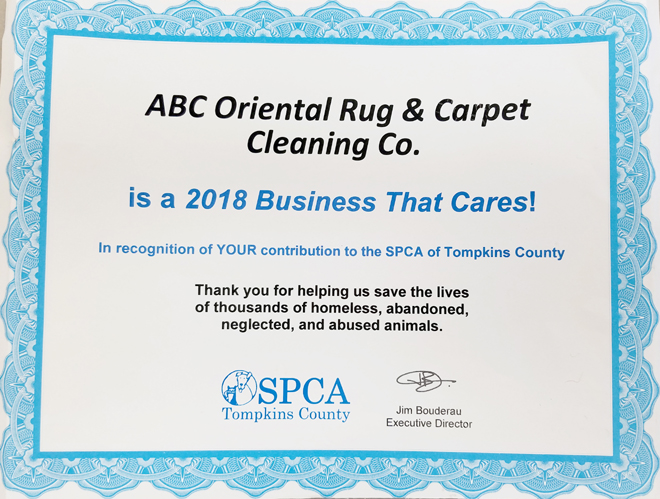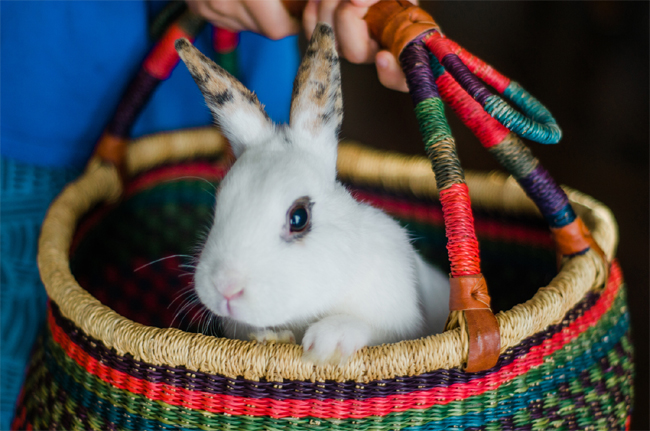ABC MONTHLY NEWSLETTER
April 2020
Welcome to Our Monthly Newsletter!
We hope you will enjoy this month's articles.
This month's topics are:
COVID-19 PANDEMIC
Important ABC Procedural Changes
Soaps, Sanitizers, and Disinfectants
AREA RUGS
CONSIGNMENT RUGS FOR SALE REMINDER
If there is a topic you would like us to cover in one of our upcoming newsletters, please call us at
607-272-1566
or contact us by clicking here.
GREAT NEWS!
GOT QUESTIONS?
NOW YOU CAN TEXT US at
607-272-1566
LATEST UPDATE ON ABC PROCEDURAL CHANGES
Please note: In anticipation of the possible lifting of the Shelter in Place ban in New York State in the near future, some of the procedural changes listed below may be altered.
Please also note: When we do resume full-time hours, all discounts from March 2020 will be honored in the re-opening month.
Please call our office at 607-272-1566, text us at 607-272-1566, email us at info@abcclean.com or view our website or our Facebook page for up to date information. Thank you.
IMPORTANT ABC PROCEDURAL CHANGES
We hope this newsletter finds you and your loved ones in good health and spirits. The COVID-19 pandemic has brought many changes to our everyday lives.
The latest information from the CDC recommends the cleaning and sanitizing of all surfaces in homes and businesses. This includes 'soft surfaces' such as carpets, furniture, tile and grout, and area rugs.The cleaning of soft surfaces is the mainstay of our business at ABC. However, for the duration of the pandemic and for the protection of our staff and clients, we have had to make some important changes in the way we conduct business, which are now already in place:
- All residential appointments in occupied homes and businesses will be postponed until at least the week of April 6, 2020 and may have to be extended.
- Rug and furniture DROP OFF to our office is available Monday through Friday 10am to 2pm. Steps for dropping off these items are posted on our front door.
- Scheduling for FREE NO CONTACT pick-up and delivery is available. Please call or text our office at 607-272-1566.
- Scheduling of all Vacant/Unoccupied Homes and Businesses for carpet, furniture, tile and grout cleaning will be available from March 30th forward.
- We will be closed on Saturdays until further notice.Please feel free to call or text our office at 607-272-1566 or visit our website.
Thank you.
The Staff and Management at ABC
CLEANING FOR HEALTH
and the COVID-19 PANDEMIC
It is April of 2020 and we would be remiss not to produce an article on the importance of cleaning for health, especially in regard to the COVID-19 (coronavirus) pandemic.
There has been so much information, as well as misinformation about this virus, from so many sources, it has been difficult for many of us to feel comfortable with how we should respond.
The worldwide data, as alarming as it has become, is still insufficient. The scary part of this coronavirus is how it is spread. Many can have the disease and spread it and have no symptoms.
We have watched the rise of confirmed cases in almost every area of the globe and in all 50 states. The statistics are astounding, with countries seeing an exponential daily increase of cases. In Italy, the US, UK, and Iran alone, the average daily increase of new cases was 30% or more during March.
WHAT IS THE COVID-19 CORONAVIRUS?
According to the McGill Office for Science and Society, "We are dealing with viruses.
Whether viruses are alive or not is a long-standing philosophical question, but the bottom line is that these infectious particles cannot replicate on their own. They attach to our cells, enter, and release their genetic blueprint. The 'construction workers' inside our own cells use the blueprint to make more viruses. These newborn viruses burst out of our cells and repeat the process.
There's a new virus out there and it belongs to a group called coronaviruses, because the spike proteins at the surface of these viruses look like a crown, and 'corona' is Latin for crown.
Coronaviruses have been around for a while: in fact, they are responsible for a minority of cases of the common cold each year.
But, once in a while, a coronavirus that was infecting animals makes the leap into humans and manages to replicate successfully. It happened with SARS. It happened again with MERS. And now it's happening once more with a virus called SARS-CoV-2, which hit us like a bat out of hell. The disease it causes is referred to as COVID-19 (COronaVIrus Disease 2019)."
Since humans have never before been attacked by this particular virus, we have no internal defense against it. This is why it is also called a 'novel' virus.
It is possible at this time that certain anti-malarial drugs may be effective against the Covid-19 virus. The theory is that these drugs interfere with the ability of the virus to attach to receptors on cells, which is a prelude to invading the cell and hijacking the cell's machinery to replicate. A virus that cannot replicate by itself and has to use a cell's machinery to do so but cannot enter a cell cannot replicate.
Although more knowledge about how the virus spreads and its structure, etc., is continually becoming available, it may be more than a year before there will be drugs or vaccines will be readily available. The only relief until a vaccine or drug is available will be relief of symptoms.
WHAT WE DO KNOW ABOUT COVID-19
- The virus is spread in large droplets by coughing and sneezing. If someone sneezes with it, it takes about 10 feet before it drops to the ground and is no longer airborne.
- ALL surfaces, especially metal, where these droplets land are infectious for many hours and possibly days.
- This virus can only infect your lungs.
- The only way for the virus to infect the lungs of a person is through the nose or mouth via hands or by an infected cough or sneeze onto or into the nose or mouth.
- Face masks will not prevent the virus in a direct sneeze from getting into your nose or mouth. A face mask is only to keep you from touching your nose or mouth after your hands have touched an infected surface.
WHAT WE CAN DO TO AVOID COVID-19 INFECTION
Please continue reading here for how to avoid COVID-19 infection, as well as what not to do, what to have on hand, and how ABC can help.
SOAPS, SANITIZERS, and DISINFECTANTS
How to Effectively Prevent COVID-19 Infections
Three of the most effective ways to prevent COVID-19 infections are:
- hand washing with soap and water.
- the use of hand sanitizers when washing with soap and water is not available.
- the use of disinfectants on surfaces in our homes and businesses.
SOAPS
All the information we have received thus far about the COVID-19 (coronavirus) stresses that washing hands with soap and water regularly is one of the most effective ways of preventing infection.
WHY HAND WASHING WITH SOAP and WATER IS SO IMPORTANT
In the case of viruses, the entry into the body is through the mouth, nose, or eyes, and that is most likely to happen by touching the face with contaminated hands.
Soapy water washes away microbes very effectively from hands, better than just water. That is because our skin is coated with sebum, a mixture of fatty materials that prevent dryness by inhibiting the evaporation of moisture from the skin
Viruses can embed themselves in this fatty layer. Since water and fat do not mix, rinsing with just water is ineffective. But soap is what is called a 'surfactant.' This is a molecule that has a water-soluble end and an oil-soluble end. One end attracts oil, the other water, and this allows oily deposits to be rinsed away.
Coronaviruses have a protective coating of proteins and fats. Because of this ability to 'wash away' fatty materials, washing with soap and water also washes away the fat layer that protects the coronavirus. This will effectively kill the virus.
As written by Dr. Joe Schwarcz on the McGill University Office for Science and society website:
"In the case of COVID-19, soap can actually destroy the virus responsible for the disease. Coronaviruses are composed of a core of nucleic acids, either RNA or DNA, surrounded by a protective coating made of proteins and fats. The fat-soluble end of the soap molecule embeds itself in the lipid layer and the virus is then literally pulled apart since the rinsing water is tugging the other end. The reason for the 20-30 second time period is to ensure that the soap makes contact with whatever microbes may be present."
WHICH IS MORE EFFECTIVE?
LIQUID SOAP or BAR SOAP
Liquid Soap
Liquid soap is not actually a soap but a 'synthetic detergent' that was originally developed for laundry purposes. As far as cleaning action goes, it doesn't make any difference whether you use a liquid or bar soap. But from an environmental point of view bar soap wins. Liquid soap has a carbon footprint about 25% greater than that of bar soap.
Liquid Soap Downsides
- Liquid soap requires a plastic bottle that takes more energy to produce than the wrapping of a bar of soap.
- The container of liquid soap is usually made of recyclable (yet often doesn't get recycled) high-density polyethylene (HDPE) which requires petroleum or natural gas for production.
- Water makes up most of liquid soap, making it heavier and requiring more energy to transport.
- On average, people use about 2.3 grams of liquid soap to wash their hands but only about .35 grams of a bar soap. This means, of course, the greater use of raw materials, more processing, and more carbon dioxide emissions.
- Liquid soap also costs about ten times as much to wash your hands than bar soap. Even bar soap harboring bacteria will not leave a residue on hands. All the bacteria will be washed away with the soap.
Bar Soap Downsides
More hot water is used with bar soap.The raw material in the making of bar soap is usually a vegetable fat, such as palm or olive oil (Palmolive), so that agricultural chemicals and land use have to be taken into account.
DRYING AFTER WASHING HANDS IS AS CRITICAL AS WASHING FREQUENTLY!
We know that whether you use bar or liquid soap, the important thing is to wash hands frequently! Just as important is to dry them well after washing! That is critical because moist hands are much more likely to pick up microbes from a surface.
Although electric hand driers can be generally effective, people don't use them long enough to dry their hands completely.
Paper towels are a much better option. Not only because they can dry your hands better but you can also then use them to close the faucets and touch the doorknob just in case the person before you had failed to practice safe hand washing techniques.
SANITIZERS
Please continue reading here for information on sanitizers and disinfectants as well as a video on the proper washing of hands to prevent infection. Also stated is the answer to the question of whether hand sanitizer is toxic to dogs as well as recipes for hand sanitizer and disinfectants and how ABC can help.
WRINKLED RUGS
Why Do Some Rugs Wrinkle?
Wrinkled rugs can be a bit of a mystery. Why some rugs wrinkle or buckle can often be explained for 1 of 3 reasons:
1. Preexisting conditions caused by the weaving process.
2. The environment the rug lives in.
3. A cleaning process that may not have been appropriate for the rug.
Below are five scenarios that can create wrinkled rugs and the underlying source of each problem:
REASON #1 - THE WRONG FLOOR UNDERNEATH
Rugs are ideally placed over a hard surface. They are not meant to cover soft surfaces. When a rug owner chooses to place rugs over wall-to-wall carpet, if the rugs are pliable and there is furniture on top of them, wrinkled rugs may be the result.
In the worst-case scenarios, there will be stretching and, eventually, structural damage to the foundation fibers of the rugs.
A pad designed to use under rugs placed on top of wall-to-wall carpet may help to hold a rug in place and in shape. However, the best situation for the longevity of a rug is to place it on top of a hard floor.
REASON #2 - WEAVING TENSION CHANGE
In some rugs, and much more evident in tribal rugs, wrinkled rugs can be the result of a change in the weaving tension.
If a rug is woven on a nomadic loom (one that is moved during the weaving process), then creating the same consistent tension can be a challenge. These tension changes in the foundation fibers can sometimes manifest themselves as uneven edges, field (central area) wrinkles or creases, or areas of width or length differences.
If the weaver changes weaving styles, for example, moving from knotting the pile to stitching a tapestry weave, this can create wrinkling in those areas of structural change. This type of wrinkling can usually be seen along an end finish where a weaver may have an elaborate kilim (flat area) weft (side to side) design finish to complete a piled rug. The wrinkling or buckling in this case is a characteristic of the weave and is often accepted as part of its unique rug personality rather than a 'flaw.'
REASON #3 - BAD PRODUCT
Some rugs wrinkle because they are made poorly. Most of today's poorly made, cheaper wool rugs come from India and are sold through many of the mass-market rug stores.
Hand tufted rugs from India, the cheaper ones with material covering up the back side of the rug, use poor quality latex to hold the rugs together. As this latex delaminates, there will not only be a messy powder residue that gets all over the floor, but there will also be wrinkles that develop along the edges and in areas of foot traffic or furniture placement.
The latex in these rugs is what holds the rug in shape and square. If the lumps are slight wrinkles, these can sometimes be pressed back flat again. If they are areas stretched out of shape, it may be possible to replace the backing with new latex and material to try to attain the original rectangular shape.
The newest rugs that show wrinkling problems are referred to as India 'hand-loomed' rugs. These are loosely constructed rugs attempting to give the look of a hand-knotted woven rug, but they are a vastly inferior product.
With these rugs it is possible to pull along the corner of the rug and actually see the warps (up and down cords) and the wefts (side to side cords) move in your hands because they are loosely strung together. In high traffic areas, these rugs can split and pull apart. Any attempts at cleaning on-site will pull the warps and cause tearing.
These rugs are currently sold in all the major rug retail stores. As more customers discover they have purchased a rug that will not hold itself together, it is hoped there will be enough complaints to pull them off the market.
REASON #4
Please continue reading here for more information on wrinkled rugs with photos.
APRIL SPECIALS
Please check our website and our Facebook page to keep up to date during these uncertain COVID-19 times.
We will continue to offer:
- FREE SANITIZER with every cleaning,
- FREE PICKUP and DELIVERY
- 3 months FREE STORAGE on items brought to our plant after payment.
Please call our office at
607-272-1566
for details!
THANK YOU!! WE LOOK FORWARD TO CONTINUING TO SERVE YOUR TEXTILE CLEANING AND REPAIR NEEDS!
Get New Posts Right To Your Inbox!
Get our monthly newsletter, just like this one, delivered right to your inbox each day. Just sign up and we will send you the best new articles and videos as they become available.
Your email address will NEVER be spammed, sold, or shared. You are welcome to unsubscribe at any time with the link in the email.
"The Cleanest Clean You've Ever Seen."
by
ABC Oriental Rug & Carpet Cleaning Co.
130 Cecil Malone Drive Ithaca, NY 14850
607-272-1566

ABC
Carpet & Rug
Spotting Guide

ABC Oriental Rug & Carpet Cleaning Co. has been family-owned and operated in Ithaca and surrounding areas for more than 49 years.
Our company is a reflection of our family name and pride.
Please Like us on Facebook!
for more information and to find out what we are doing at our business and in the community!
Stay Connected!
Links to Our Services
Allergy Cleaning
Area Rug Cleaning
Oriental Rug Cleaning
Rug Hand & Machine Repair
Upholstered Furniture Cleaning
Tile & Grout Cleaning & Sealing
We are proud sponsors of the SPCA of Tompkins CO:

Newsletter Archives


